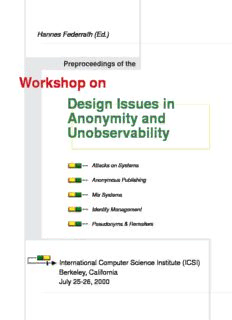
Design Issues in Anonymity and Unobservability Workshop on PDF
Preview Design Issues in Anonymity and Unobservability Workshop on
Hannes Federrath (Ed.) Preproceedings of the Workshop on Design Issues in Anonymity and Unobservability Attacks on Systems Anonymous Publishing Mix Systems Identity Management Pseudonyms & Remailers International Computer Science Institute (ICSI) Berkeley, California July 25-26, 2000 Hannes Federrath (Ed.) Proceedings of the Workshop on Design Issues in Anonymity and Unobservability International Computer ScienceInstitute(ICSI) Berkeley, California July 25-26,2000 ThisdocumentisalsoTechnicalReportTR-00-011ofICSI. InternationalComputerScienceInstitute 1947CenterSt.,Suite600 Berkeley,CA94704-1198 Phone: (510)666-2900 Fax: (510)666-2956 http://www.icsi.berkeley.edu Contents TrafficAnalysis: Protocols,Attacks,DesignIssuesandOpenProblems ...........................7 Jean-Fran¸coisRaymond ThedisadvantagesoffreeMIXroutesandhowtoovercomethem .............................. 27 OliverBerthold,RonnyStandtke,AndreasPfitzmann Freenet: ADistributed AnonymousInformationStorageandRetrievalSystem ...................43 IanClarke,OskarSandberg,BrandonWiley, TheodoreW.Hong TheFreeHavenProject: DistributedAnonymousStorageService ...............................59 RogerDingledine,MichaelFreedman,DavidMolnar TowardsanAnalysisofOnionRoutingSecurity ...............................................83 PaulSyverson,GeneTsudik,MichaelReed,CarlLandwehr WebMIXes: AsystemforanonymousandunobservableInternetaccess ........................101 OliverBerthold,HannesFederrath,StefanKo¨psell PrivacyIncorporatedSoftwareAgent(PISA):Proposalforbuildinga privacyguardianfortheelectronicage ......................................................117 JohnBorking IdentityManagementBasedOnP3P ........................................................127 OliverBerthold,MaritKo¨hntopp OnPseudonymizationofAuditDataforIntrusionDetection .................................147 JoachimBiskup,UlrichFlegel ProtectionProfilesforRemailer Mixes ......................................................165 KaiRannenberg,GiovanniIachello Preface ThisworkshopaddressesthedesignandrealizationofanonymityservicesfortheInternetandothercommu- nicationnetworks. Themaintopicsoftheworkshopare AttacksonSystems, (cid:15) AnonymousPublishing, (cid:15) MixSystems, (cid:15) IdentityManagement,and (cid:15) Pseudonyms&Remailers. (cid:15) Anonymityandunobservabilityhavebecomea“hottopic”ontheInternet. Servicesthatprovideanonymous andunobservable access to theInternetareuseful for electronic commerce applications (obviously with the need for strong authenticity and integrity of data) as well as for services where the user wants to remain anonymous(e.g. web-basedadvisoryservicesorconsultancy). I would like to thank the other members of program committe John Borking, Marit Ko¨hntopp, Andreas Pfitzmann, Avi Rubin, Adam Shostack, Michael Waidner, and Sonja Zwissler for their helpful hints, for doing thereviews andfor theirpatience. A special thankis dedicated to Lila Finhill of ICSI for herhelpin alladministrativeandfinancialconcerns,andChristianSchindelhauerforhissupportonLaTeX. Berkeley,July2000 HannesFederrath Traffic Analysis: Protocols, Attacks, Design Issues and Open Problems Jean-Franc¸oisRaymond Zero-Knowledge Systems, Inc. [email protected] Abstract Wepresentthetrafficanalysisproblemandexposethemostimportantprotocols,attacksanddesign issues. Afterwards,weproposedirectionsforfurtherresearch. As we are mostly interested in efficient and practical Internetbasedprotocols, most of the emphasis is placed on mix based constructions. The presentation is informal in that no complex definitions and proofs are presented, the aim being more to give a thorough introduction than to present deep new insights. 1 Introduction Privacy is becoming a critical issue on the Internet. Polls constantly remind us that users feel that one of themost importantbarriers tousingtheInternetisthefearofhavingtheirprivacy violated. Unfortunately, thisisn’tunjustifiedasmarketersandnationalsecurityagencieshavebeenveryaggressiveinmonitoringuser activity1. Two things can happen as a result of this lack of privacy: either the Internet’s popularity diminishes or, as seemsmorelikely,theInternetbecomesthemostpervasivesurveillancesystemever. Theproblemstudiedin this text isn’t a purely theoretic one, in fact some would argue that it is a crucial one to solve if the online worldistocontinueexpandingandimproving. Inanycase,fromboththeoreticalandpracticalperspectives, itcertainlydeservestoreceivemuchmoreattentionthanithasgottensofar. 1.1 Desirable Properties Our goal is to protect users against traffic analysis. That is, we don’t want an adversary that can monitor and/or compromise certain parts of the systems to be able to match a message sender with the recipient (sender-recipient matchings). A related problem is that of network unobservability which attempts to hide all communication patterns. (how many, at what time and to whom/from whom messages are sent and received). Notice that network unobservability impliestheineffectivenessoftrafficanalysis. 1Seehttp://www.freedom.netandhttp://www.inf.tu-dresden.de/˜hf2/anonforexamples. 7 Whereasmessageprivacy canbeobtainedusingencryption,it’smuchhardertoprotectsenderand/orrecip- ient privacy; especially in large open networks. The number of different assumptions and settings is huge whichmakesitdifficult todefineandreasonabouttheprobleminarigorousmanner. As with manyconstructions in cryptography, there are efficiency, practicality/security tradeoffs to be made. For example, if efficiency and practicality weren’t issues, we could broadcast messages in order to protect recipientprivacy. Noticethattheproblem definition isn’tentirely trivial. Wecan’tprovide ”perfect”privacy sincethenumber ofpossible sendersandrecipients isbounded. So, forexample, ifthereareonlytwopartiesonthenetwork, anattackerhavingaccesstothisinformationcantrivially determinewhoiscommunicatingwithwhom ::: Thebest wecanhopeforistomakeallpossible sender-recipient matchingslook equally likely. Thatis, the attacker’s view2’s statistical distribution should be independent from the actual sender-recipient matchings. The protocol of subsection 2.2 has this strong property whereas those of subsection 2.3 usually don’t. Un- fortunately, there are no satisfactory definitions/methods providing a solid framework in which to analyze protocols that fall short of the optimal performance3 and we usually need to rely on more or less ad-hoc arguments. 1.2 Overview Aconciseliteraturereviewcanbefoundinsection2. Acomprehensivelistingofattacksagainstmix-networks ispresentedinsection3. Designissuesrelatedtolargemixbasednetworksaregiveninsection4. Wepropose directionsforfurtherresearchinsection5andconcludeinsection6. 2 Literature Review Before delving more deeply into the problem, we briefly review some privacy protecting mechanisms. Al- though the link between these and sender-recipient privacy can be tenuous in certain instances, we believe thatsomeoftheideasusedinthesetechniquesmightbeuseful. 2.1 Related Problems SecureMultiPartyComputations(SMPC)[14]: Agroupofusers,eachhavingaprivateinput,wantto (cid:15) securely computeafunctionoftheirprivateinputs. Attheendoftheprotocol, allusersshouldknow onlythevalueofthefunction. Thatis,eachuserwillnothavegainedanyinformationabouttheother users’privateinputsapartfromwhatcanbededucedfromthefunction’svalue. Oblivious RAM [22]: Code privacy can be protected by using a tamper resistant cryptographic pro- (cid:15) cessor. Theprotocol is such than an outside party looking at thememory accesses (reads and writes) can’t gain any information about what is being computedand how it is being computed. The code’s privacyisprotectedwhichcouldbeusefultopreventreverseengineeringandsoftwarepiracy. 2Byview,wemeanalltheinformationavailabletotheattacker. 3i.e.protocolsinwhichtrafficanalysiscanhelpinobtainingsomenon-trivialinformationaboutsender-recipientmatchings. 8
Description: